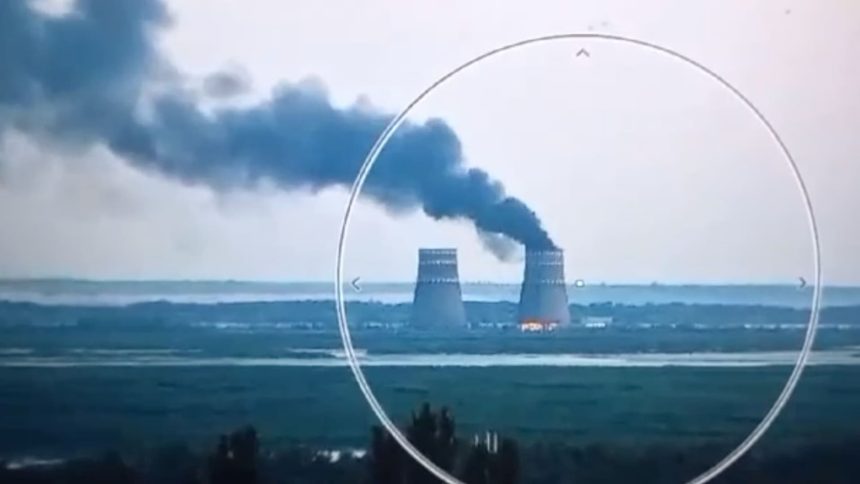Moscow and Kyiv have blamed each other for a large fire that broke out at the Zaporizhzhia Nuclear Power Plant in southern Ukraine on Sunday, with the latest incident taking place amid Ukraine’s ongoing incursion into Russian border territory.
Ukrainian officials said Russian forces started the fire at the plant, which has been occupied since March 2022, while the Kremlin-installed governor of Zaporizhzhia said Ukrainian shelling was the cause of the blaze.
The occupied nuclear power plant has been a frequent flashpoint between Ukraine and Russia, which have repeatedly accused each other of launching high-risk drone and shelling attacks on or near the plant, endangering the facility’s safety and risking a nuclear disaster.
In the latest flaring of tensions, Ukraine’s President Volodymyr Zelenskyy accused Russian forces of starting a fire at the ZNPP in the town of Enerhodar, but said that local radiation levels were normal.
“As long as Russian terrorists retain control of the nuclear power plant, the situation is not and cannot be normal. Since the first day of the seizure of Zaporizhzhya NPP, Russia has been using it solely to blackmail Ukraine, the whole of Europe and the world,” Zelenskyy said.
The Russian-installed governor of Zaporizhzhia countered the claim, stating in a Google-translated social media update that Ukrainian shelling was to blame for the fire at the facility, which is Europe’s largest nuclear power plant.
Posting on Telegram, Yevgeny Balitsky said an unmanned aerial vehicle (UAV) struck one of the cooling towers of the plant and caught fire, adding that emergency services in the region had localized and extinguished the flames.
“The Ukrainian regime, supported by NATO curators, is systematically shelling the entire north of the Zaporizhia region, where UAVs, barrel artillery, and mortar artillery can reach. But all measures are being taken to localize the consequences of these strikes,” Balitsky claimed.
He said he had met with Russia’s President Vladimir Putin who had “clearly indicated increasing vigilance and attention to strategic infrastructure facilities, which include the nuclear power plant.”
Neither side presented evidence for their claims. CNBC was not able to verify their reports.
The International Atomic Energy Agency (IAEA), which has maintained a rotating team of inspectors at the Zaporizhzhia site in a bid to maintain safety protocols, said in a statement on X Sunday evening that its experts had witnessed “strong dark smoke” coming from the northern area of the plant, following “multiple explosions” throughout the evening.
The UN’s nuclear watchdog said it had been informed about an alleged drone attack earlier Sunday on one of the cooling towers. The IAEA said that, for now, there has been no impact on nuclear safety.
Tempers flaring
Tensions between Moscow and Kyiv have intensified further in recent days, following an incursion by Ukrainian forces into the Russian border region of Kursk.
The border raid began last Tuesday and seemed to catch Moscow by surprise, with Russia’s defense ministry revising initial estimates to say last Thursday that around 1,000 troops and numerous tanks and armored vehicles took part in the incursion.
On Sunday, an unnamed senior Ukrainian security official told the AFP news agency that “thousands” of troops were engaged in the operation, which marked a bid to “stretch” and “destabilize” Russia. CNBC could not verify the report.
Around 3,000 people have been evacuated from the region amid ongoing Ukrainian drone and missile attacks, according to acting regional Governor Alexei Smirnov. He posted on Telegram Monday that the threat of UAV attacks was ongoing, stating overnight that Russian “air defense forces and assets have been put on alert to repel a possible attack.”
As a result, Kyiv’s incursion has disrupted Russia’s summer offensive in eastern Ukraine, forcing Moscow to redeploy forces to Kursk.
Over the last week, Russian defense officials have claimed that their factions have prevented Ukrainian advances into Kursk. Geolocated footage and Russian military bloggers meanwhile suggest Ukrainian troops are present in areas up to 35 kilometers inside Russia, according to analysis from the Institute for the Study of War think tank.
Ukraine’s operation in Kursk has allowed Ukrainian forces to at least temporarily seize the battlefield initiative in one part of the frontline, the ISW noted.
“Russia’s possession of the theater-wide initiative since November 2023 has allowed Russia to determine the location, time, scale, and requirements of fighting in Ukraine and forced Ukraine to expend materiel and manpower in reactive defensive operations,” the ISW said.
“The Ukrainian operation in Kursk Oblast [region], however, has forced the Kremlin and Russian military command to react and redeploy forces and means to the sector where Ukrainian forces have launched attacks.”
The ISW suggested that Putin and the Russian military command “likely incorrectly assessed that Ukraine lacked the capability to contest the initiative.”
Ukraine has been characteristically tight-lipped about its latest operation into Russian border territory. Kursk is one of several border regions that have experienced smaller and shorter incursions and been hit with more frequent Ukrainian drone attacks and shelling in recent months.
Russia and Ukraine say they don’t target civilian areas.
President Zelenskyy acknowledged the raid on Sunday, however, referring to Ukrainian “actions to push the war into the aggressor’s territory.”
Zelenskyy said he was grateful to Ukrainian units “that ensure this” and that “Ukraine is proving that it is really able to bring justice and guarantees exactly the kind of pressure that is needed — pressure on the aggressor.”
Read the full article here




